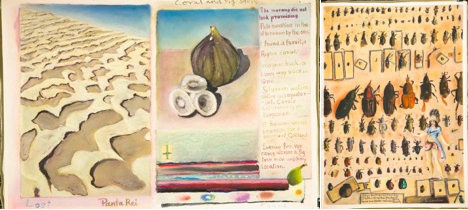Richard Sexton has a name he can play with. Luckily, he also plays with images.
The theme of his current exhibition at the Mornington Hotel on Nybrogatan is Darwin, the Light of Reason and the Pursuit of the Marvellous. It’s the playful Darwin: discoveries and unexpected juxtapositions.
The works are oil pastel drawings, juggling the definition with paintings. Many incorporate handwritten messages – a sort of ‘BTW’ to make you forget medium modes.
Here’s Vladimir Nabokov, splashed in oil pastels, a summer snapshot of a tentative father’s hand on his son’s shoulder. Beside them, in clear, casual script is: “Je suis dépaysé, partout et toujours.” It’s a sentiment that many of us share, and Nabokov is saying it’s a proud profession.
The frames are hung in the Mornington’s glassy lobby, backs turned to Östermalm’s scurrying well dressed. Once in the bookshelf-lined lobby you think you’re in the hotel’s library. Actually you don’t of course, but I like the theme. A central pillar has cleverly become a pillar-bookshelf.
Inside, Richard Sexton’s frames now compete with the outside parade, but since you have to go close to read the frequent drawn messages or book titles (harmonising accidentally with the lobby, a second theme is book covers), you don’t notice middle distance.
On one drawing of a book cover, an African woman crooks a knee and smiles, sunny red dress and big hat beaming with her. The name of the book is Standing Dreaming. (The drawing of book covers leads you down another path to another medium — a third theme.)
Sexton suggests that the woman is dreaming of becoming president or prime minister. The power of aspiration is everywhere.
Richard Sexton’s earlier work was mostly with hand-made pigment paints. Inspiration has taken him often to Asia, Africa and, in one wild flight of inquisitiveness, to the desert outside Geraldton on the windswept heat of the Western Australian coast.
Bugs and beetles abound in the drawings, dying to tell us stories about nature. But “Ceci n’est pas un conte,” cautions one drawing. Another shows fragments of Rugosa fossil (an extinct order of coral) and a fig – and it’s Fårö Island! Fig trees on Gotland? Don’t get Sexton started on the shifting tectonic plates. Or rather, do, because you’ll be listening to that same joy of discovery so clearly visualised in his pictures.
Sexton and his partner Miriam were on Fårö looking for the legendary hidden Engelska kyrkogården. Fårösund was a British naval base during the Crimean war in the mid-19th century. A few English seamen were hastily buried there, and almost forgotten, after succumbing in a cholera epidemic.
It’s an exhibition of bright juxtapositions, thematic and visual. Plus richness, fun and quirky wisdom.
Were there sixteen paintings? I didn’t count.
By Kim Loughran, whose book, The Year in Sweden, is on sale now at the AdLibris online bookstore.



 Please whitelist us to continue reading.
Please whitelist us to continue reading.
Member comments